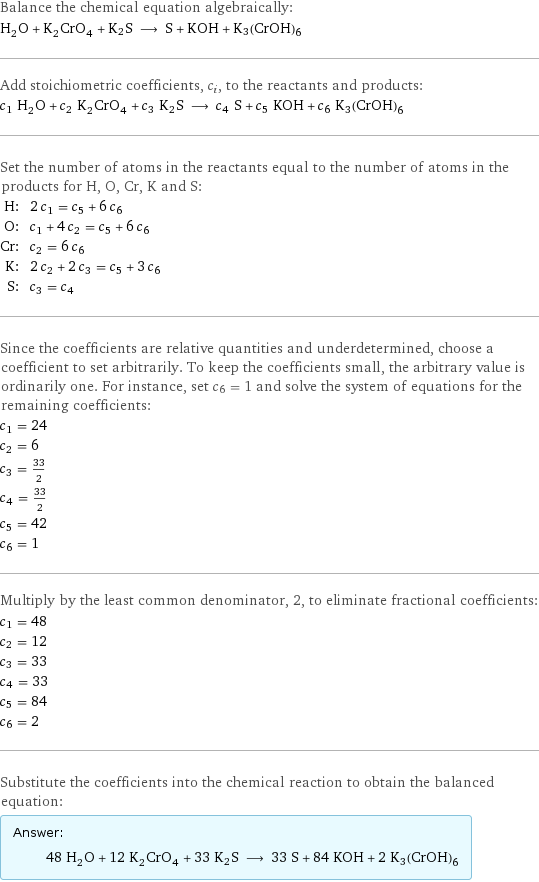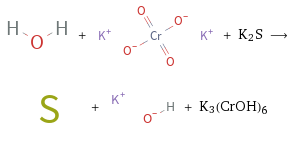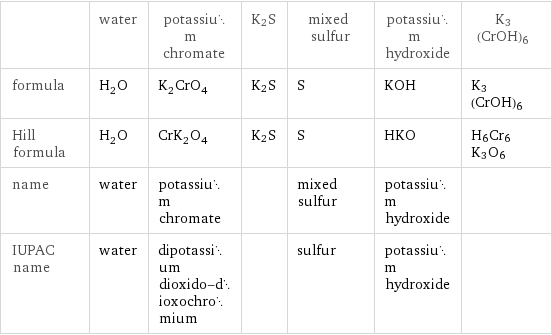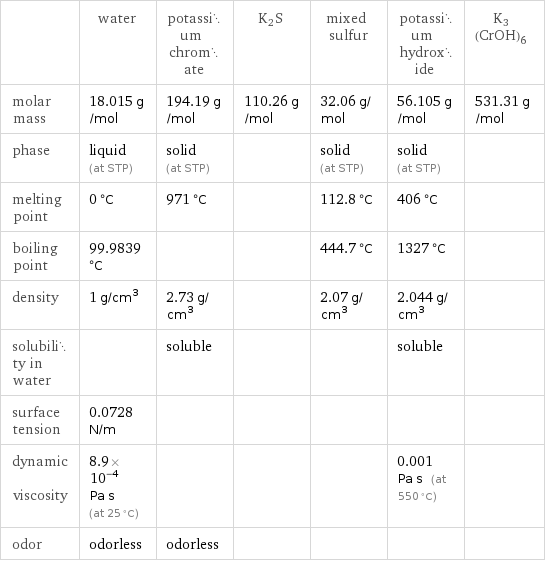Input interpretation

H_2O water + K_2CrO_4 potassium chromate + K2S ⟶ S mixed sulfur + KOH potassium hydroxide + K3(CrOH)6
Balanced equation

Balance the chemical equation algebraically: H_2O + K_2CrO_4 + K2S ⟶ S + KOH + K3(CrOH)6 Add stoichiometric coefficients, c_i, to the reactants and products: c_1 H_2O + c_2 K_2CrO_4 + c_3 K2S ⟶ c_4 S + c_5 KOH + c_6 K3(CrOH)6 Set the number of atoms in the reactants equal to the number of atoms in the products for H, O, Cr, K and S: H: | 2 c_1 = c_5 + 6 c_6 O: | c_1 + 4 c_2 = c_5 + 6 c_6 Cr: | c_2 = 6 c_6 K: | 2 c_2 + 2 c_3 = c_5 + 3 c_6 S: | c_3 = c_4 Since the coefficients are relative quantities and underdetermined, choose a coefficient to set arbitrarily. To keep the coefficients small, the arbitrary value is ordinarily one. For instance, set c_6 = 1 and solve the system of equations for the remaining coefficients: c_1 = 24 c_2 = 6 c_3 = 33/2 c_4 = 33/2 c_5 = 42 c_6 = 1 Multiply by the least common denominator, 2, to eliminate fractional coefficients: c_1 = 48 c_2 = 12 c_3 = 33 c_4 = 33 c_5 = 84 c_6 = 2 Substitute the coefficients into the chemical reaction to obtain the balanced equation: Answer: | | 48 H_2O + 12 K_2CrO_4 + 33 K2S ⟶ 33 S + 84 KOH + 2 K3(CrOH)6
Structures

+ + K2S ⟶ + + K3(CrOH)6
Names

water + potassium chromate + K2S ⟶ mixed sulfur + potassium hydroxide + K3(CrOH)6
Equilibrium constant
![Construct the equilibrium constant, K, expression for: H_2O + K_2CrO_4 + K2S ⟶ S + KOH + K3(CrOH)6 Plan: • Balance the chemical equation. • Determine the stoichiometric numbers. • Assemble the activity expression for each chemical species. • Use the activity expressions to build the equilibrium constant expression. Write the balanced chemical equation: 48 H_2O + 12 K_2CrO_4 + 33 K2S ⟶ 33 S + 84 KOH + 2 K3(CrOH)6 Assign stoichiometric numbers, ν_i, using the stoichiometric coefficients, c_i, from the balanced chemical equation in the following manner: ν_i = -c_i for reactants and ν_i = c_i for products: chemical species | c_i | ν_i H_2O | 48 | -48 K_2CrO_4 | 12 | -12 K2S | 33 | -33 S | 33 | 33 KOH | 84 | 84 K3(CrOH)6 | 2 | 2 Assemble the activity expressions accounting for the state of matter and ν_i: chemical species | c_i | ν_i | activity expression H_2O | 48 | -48 | ([H2O])^(-48) K_2CrO_4 | 12 | -12 | ([K2CrO4])^(-12) K2S | 33 | -33 | ([K2S])^(-33) S | 33 | 33 | ([S])^33 KOH | 84 | 84 | ([KOH])^84 K3(CrOH)6 | 2 | 2 | ([K3(CrOH)6])^2 The equilibrium constant symbol in the concentration basis is: K_c Mulitply the activity expressions to arrive at the K_c expression: Answer: | | K_c = ([H2O])^(-48) ([K2CrO4])^(-12) ([K2S])^(-33) ([S])^33 ([KOH])^84 ([K3(CrOH)6])^2 = (([S])^33 ([KOH])^84 ([K3(CrOH)6])^2)/(([H2O])^48 ([K2CrO4])^12 ([K2S])^33)](../image_source/7d8e2c72fda8060dc7f7441a39eceada.png)
Construct the equilibrium constant, K, expression for: H_2O + K_2CrO_4 + K2S ⟶ S + KOH + K3(CrOH)6 Plan: • Balance the chemical equation. • Determine the stoichiometric numbers. • Assemble the activity expression for each chemical species. • Use the activity expressions to build the equilibrium constant expression. Write the balanced chemical equation: 48 H_2O + 12 K_2CrO_4 + 33 K2S ⟶ 33 S + 84 KOH + 2 K3(CrOH)6 Assign stoichiometric numbers, ν_i, using the stoichiometric coefficients, c_i, from the balanced chemical equation in the following manner: ν_i = -c_i for reactants and ν_i = c_i for products: chemical species | c_i | ν_i H_2O | 48 | -48 K_2CrO_4 | 12 | -12 K2S | 33 | -33 S | 33 | 33 KOH | 84 | 84 K3(CrOH)6 | 2 | 2 Assemble the activity expressions accounting for the state of matter and ν_i: chemical species | c_i | ν_i | activity expression H_2O | 48 | -48 | ([H2O])^(-48) K_2CrO_4 | 12 | -12 | ([K2CrO4])^(-12) K2S | 33 | -33 | ([K2S])^(-33) S | 33 | 33 | ([S])^33 KOH | 84 | 84 | ([KOH])^84 K3(CrOH)6 | 2 | 2 | ([K3(CrOH)6])^2 The equilibrium constant symbol in the concentration basis is: K_c Mulitply the activity expressions to arrive at the K_c expression: Answer: | | K_c = ([H2O])^(-48) ([K2CrO4])^(-12) ([K2S])^(-33) ([S])^33 ([KOH])^84 ([K3(CrOH)6])^2 = (([S])^33 ([KOH])^84 ([K3(CrOH)6])^2)/(([H2O])^48 ([K2CrO4])^12 ([K2S])^33)
Rate of reaction
![Construct the rate of reaction expression for: H_2O + K_2CrO_4 + K2S ⟶ S + KOH + K3(CrOH)6 Plan: • Balance the chemical equation. • Determine the stoichiometric numbers. • Assemble the rate term for each chemical species. • Write the rate of reaction expression. Write the balanced chemical equation: 48 H_2O + 12 K_2CrO_4 + 33 K2S ⟶ 33 S + 84 KOH + 2 K3(CrOH)6 Assign stoichiometric numbers, ν_i, using the stoichiometric coefficients, c_i, from the balanced chemical equation in the following manner: ν_i = -c_i for reactants and ν_i = c_i for products: chemical species | c_i | ν_i H_2O | 48 | -48 K_2CrO_4 | 12 | -12 K2S | 33 | -33 S | 33 | 33 KOH | 84 | 84 K3(CrOH)6 | 2 | 2 The rate term for each chemical species, B_i, is 1/ν_i(Δ[B_i])/(Δt) where [B_i] is the amount concentration and t is time: chemical species | c_i | ν_i | rate term H_2O | 48 | -48 | -1/48 (Δ[H2O])/(Δt) K_2CrO_4 | 12 | -12 | -1/12 (Δ[K2CrO4])/(Δt) K2S | 33 | -33 | -1/33 (Δ[K2S])/(Δt) S | 33 | 33 | 1/33 (Δ[S])/(Δt) KOH | 84 | 84 | 1/84 (Δ[KOH])/(Δt) K3(CrOH)6 | 2 | 2 | 1/2 (Δ[K3(CrOH)6])/(Δt) (for infinitesimal rate of change, replace Δ with d) Set the rate terms equal to each other to arrive at the rate expression: Answer: | | rate = -1/48 (Δ[H2O])/(Δt) = -1/12 (Δ[K2CrO4])/(Δt) = -1/33 (Δ[K2S])/(Δt) = 1/33 (Δ[S])/(Δt) = 1/84 (Δ[KOH])/(Δt) = 1/2 (Δ[K3(CrOH)6])/(Δt) (assuming constant volume and no accumulation of intermediates or side products)](../image_source/3a1878d3c9ce2fbfd69bdbf6821f19a6.png)
Construct the rate of reaction expression for: H_2O + K_2CrO_4 + K2S ⟶ S + KOH + K3(CrOH)6 Plan: • Balance the chemical equation. • Determine the stoichiometric numbers. • Assemble the rate term for each chemical species. • Write the rate of reaction expression. Write the balanced chemical equation: 48 H_2O + 12 K_2CrO_4 + 33 K2S ⟶ 33 S + 84 KOH + 2 K3(CrOH)6 Assign stoichiometric numbers, ν_i, using the stoichiometric coefficients, c_i, from the balanced chemical equation in the following manner: ν_i = -c_i for reactants and ν_i = c_i for products: chemical species | c_i | ν_i H_2O | 48 | -48 K_2CrO_4 | 12 | -12 K2S | 33 | -33 S | 33 | 33 KOH | 84 | 84 K3(CrOH)6 | 2 | 2 The rate term for each chemical species, B_i, is 1/ν_i(Δ[B_i])/(Δt) where [B_i] is the amount concentration and t is time: chemical species | c_i | ν_i | rate term H_2O | 48 | -48 | -1/48 (Δ[H2O])/(Δt) K_2CrO_4 | 12 | -12 | -1/12 (Δ[K2CrO4])/(Δt) K2S | 33 | -33 | -1/33 (Δ[K2S])/(Δt) S | 33 | 33 | 1/33 (Δ[S])/(Δt) KOH | 84 | 84 | 1/84 (Δ[KOH])/(Δt) K3(CrOH)6 | 2 | 2 | 1/2 (Δ[K3(CrOH)6])/(Δt) (for infinitesimal rate of change, replace Δ with d) Set the rate terms equal to each other to arrive at the rate expression: Answer: | | rate = -1/48 (Δ[H2O])/(Δt) = -1/12 (Δ[K2CrO4])/(Δt) = -1/33 (Δ[K2S])/(Δt) = 1/33 (Δ[S])/(Δt) = 1/84 (Δ[KOH])/(Δt) = 1/2 (Δ[K3(CrOH)6])/(Δt) (assuming constant volume and no accumulation of intermediates or side products)
Chemical names and formulas

| water | potassium chromate | K2S | mixed sulfur | potassium hydroxide | K3(CrOH)6 formula | H_2O | K_2CrO_4 | K2S | S | KOH | K3(CrOH)6 Hill formula | H_2O | CrK_2O_4 | K2S | S | HKO | H6Cr6K3O6 name | water | potassium chromate | | mixed sulfur | potassium hydroxide | IUPAC name | water | dipotassium dioxido-dioxochromium | | sulfur | potassium hydroxide |
Substance properties

| water | potassium chromate | K2S | mixed sulfur | potassium hydroxide | K3(CrOH)6 molar mass | 18.015 g/mol | 194.19 g/mol | 110.26 g/mol | 32.06 g/mol | 56.105 g/mol | 531.31 g/mol phase | liquid (at STP) | solid (at STP) | | solid (at STP) | solid (at STP) | melting point | 0 °C | 971 °C | | 112.8 °C | 406 °C | boiling point | 99.9839 °C | | | 444.7 °C | 1327 °C | density | 1 g/cm^3 | 2.73 g/cm^3 | | 2.07 g/cm^3 | 2.044 g/cm^3 | solubility in water | | soluble | | | soluble | surface tension | 0.0728 N/m | | | | | dynamic viscosity | 8.9×10^-4 Pa s (at 25 °C) | | | | 0.001 Pa s (at 550 °C) | odor | odorless | odorless | | | |
Units
